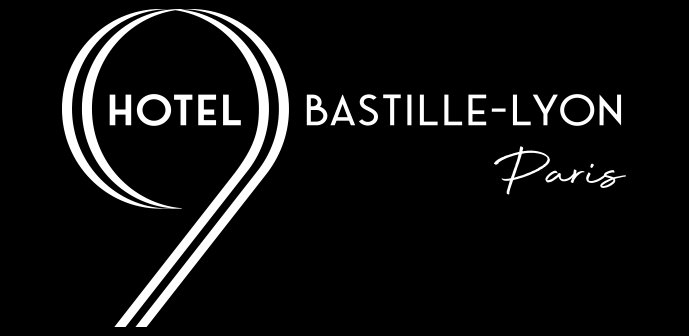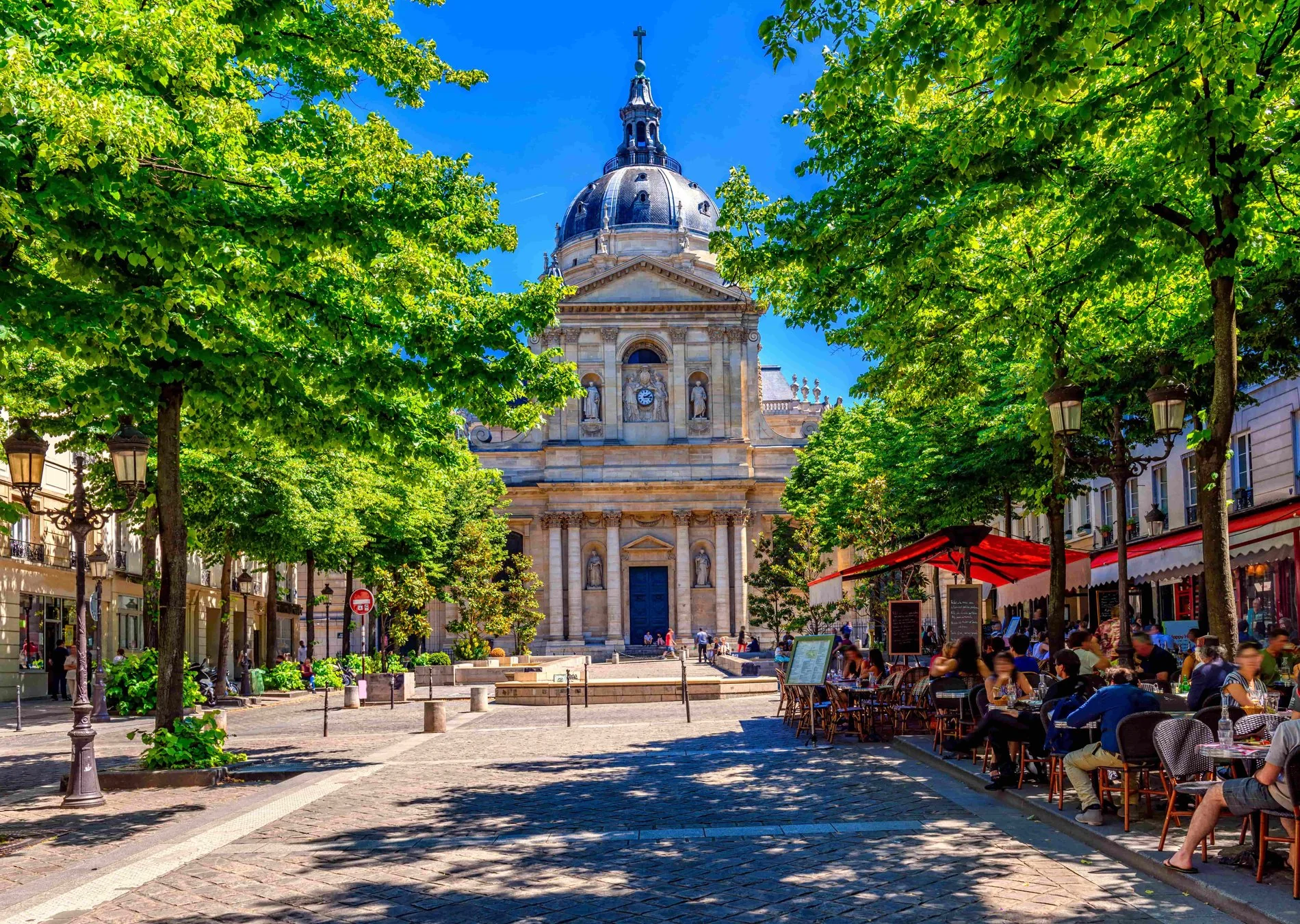Place de la Sorbonne
A Well-Located Hotel Near the Sorbonne
The most prestigious university in Paris, the Sorbonne is deeply linked to the history, student life, and political life of France. Founded during the reign of Saint Louis in the 13th century, it was within its walls that the events of May 1968 first broke out. Largely redesigned under the direction of Cardinal Richelieu, the Sorbonne today features classical facades that make it one of the most iconic landmarks of the Latin Quarter.
The Origins of the Sorbonne: A Faculty of Theology
In 1253, Robert de Sorbon, a master of theology at the Notre-Dame cloister and confessor to King Louis IX, founded the college that would bear his name. Originally from the village of Sorbon in the Ardennes, the institution—initially called the Collège Sorbon, with fluctuating spellings—eventually became known as the Collège de Sorbonne, and later simply La Sorbonne, following the Latin feminine form Sorbona, the clerical language of the time.
The king supported the project for two main reasons. First, the French crown had long been engaged in a power struggle with the papacy. At a time when the Dominican and Franciscan orders (which included scholars like Albert the Great and Thomas Aquinas) were gaining control over theology through their allegiance to the pope, King Louis IX found in Robert de Sorbon a loyal ally capable of counterbalancing their influence.
Second, Saint Louis was determined to help impoverished students. The Collège de Sorbon was thus initially established to host around twenty needy students who received a scholarship and required housing. Several houses on Rue Coupe-Gueule, facing the Hôtel de Cluny and donated by the king, served this purpose.
Officially recognized by the king in 1257, the Sorbonne functioned as a religious community where theology remained the primary discipline, but unlike monasteries, it welcomed secular priests and poor students.
A Classical Landmark in the Latin Quarter
Perched on the Montagne Sainte-Geneviève, today’s Sorbonne owes much to the architect Jacques Lemercier. After receiving a few houses from the king, Robert de Sorbon gradually acquired most of Rue de la Sorbonne by 1260, expanding the institution across what was then a patchwork of barns and houses surrounding a garden.
To impose a devout and austere lifestyle, Robert de Sorbon refrained from any grand construction. By the early 17th century, little had changed architecturally until Cardinal Richelieu, himself a former student (1606–1607), undertook a complete renovation after becoming principal in 1622.
This was the age of grand projects. With France asserting its cultural dominance under the classical era, Richelieu sought to turn the Sorbonne into not only a center of knowledge in Europe but also a building reflecting the grandeur of the nation. He commissioned Jacques Lemercier to completely redesign the Sorbonne.
The chapel was elevated, and its dome was painted by Philippe de Champaigne. After Richelieu’s death, he was entombed there in a monument sculpted by François Girardon. Construction began in May 1635 and was nearly complete at Richelieu’s death, except for the chapel, now regarded as a masterpiece of Parisian classical architecture.
The college doubled in size and inherited the cardinal's library. Richelieu, who also founded the Académie Française, significantly shaped the institution.
The Sorbonne After the French Revolution
During the French Revolution, the Sorbonne was closed to students and repurposed as a Temple of Reason. In 1806, Napoleon Bonaparte founded the Imperial University, but the Sorbonne was assigned to artists. In 1821, the faculties of science, literature, and theology returned, and the Sorbonne also became the seat of the Rector of the Paris Academy.
Under the Restoration, the cardinal’s great-nephew, Duke of Richelieu, then Prime Minister to King Louis XVIII, built a 1,200-seat amphitheater to honor the cardinal and further elevate the university's prestige.
Despite renovations, the building could no longer accommodate the growing student population. Under the Second Empire, architect Léon Vaudoyer proposed a new academic palace, but the plan was abandoned. It was eventually Henri-Paul Nénot, a student of Charles Garnier (architect of the Paris Opera), who won the project for the new Sorbonne.
His design, a perfect example of Haussmannian classicism, combined simplicity and grandeur. All buildings except the chapel were demolished between 1884 and 1894. The northern wing was inaugurated in 1889 by President Sadi Carnot, celebrating the Revolution’s centenary, and the full project was completed by 1901.
The Modern Sorbonne
The new Sorbonne building designed by Paul Nénot includes several structures across the steep northwest slope of the Montagne Sainte-Geneviève, bordered by Rue Saint-Jacques, Rue Cujas, Rue des Écoles, and Rue de la Sorbonne.
The chapel, now a listed historic monument, was preserved. To the north, the Rue des Écoles wing houses the university rectorate and administration. To the south lies the Faculty of Sciences, while the central courtyard is surrounded by lecture halls, large amphitheaters, and a central library—now home to the Faculty of Letters.
Over time, plans changed: areas initially intended for theology were allocated to the École des Chartes. In 1896, the faculties of law, letters, medicine, and science were merged into a single legal entity: the University of Paris, with the rector of the Paris Academy serving as its president.
The Sorbonne in Modern History
On May 1, 1906, Marie Curie gave the Sorbonne's first-ever lecture by a woman, replacing her late husband Pierre Curie. When she delivered her inaugural lecture on November 5, journalists, artists, and the Paris elite crowded the physics lecture hall to witness a landmark feminist moment.
In May 1968, although the student unrest began at the Nanterre campus, events escalated when the university president called in police to evict students from the Sorbonne courtyard. This sparked weeks of protests, culminating in the general strike of May 13, and the Sorbonne was occupied.
A university reform followed, dividing the University of Paris into thirteen new institutions. Since then, first-year students—often seen as more rebellious—have been sent to campuses like Censier or Clignancourt.
In March 2006, protests against the First Employment Contract (CPE) law led to the Sorbonne being occupied from March 8–11 before police cleared it. Similar protests attempted to block the university in 2009 and again in 2018, but were quickly shut down.
The Sorbonne: A Symbol of Higher Learning in the Latin Quarter
From royal to republican power, the Sorbonne has remained France’s most renowned university, still one of the most prestigious today. While currently closed to the public due to Vigipirate security measures, guided tours can be booked, and the site is accessible during European Heritage Days.
Located just steps from the Panthéon, which crowns the Montagne Sainte-Geneviève, the Sorbonne sits in the heart of the Latin Quarter—Paris's legendary student district, alive year-round with youth, knowledge, and culture.
From 9Hotel Bastille-Lyon, the Sorbonne is easily reachable. Walk across the Pont d’Austerlitz and through the Jardin des Plantes, or cross the Pont de Sully at the eastern tip of Île Saint-Louis. Whether on foot, by bike, car, metro, or bus, the journey is a scenic one. Many prefer walking above ground to enjoy one of the most beautiful parts of Paris.
The name Sorbonne continues to resonate because this university has long been a center of intellectual and political debate, and it still shines today—whether because of, or despite, the controversies it sparks.


